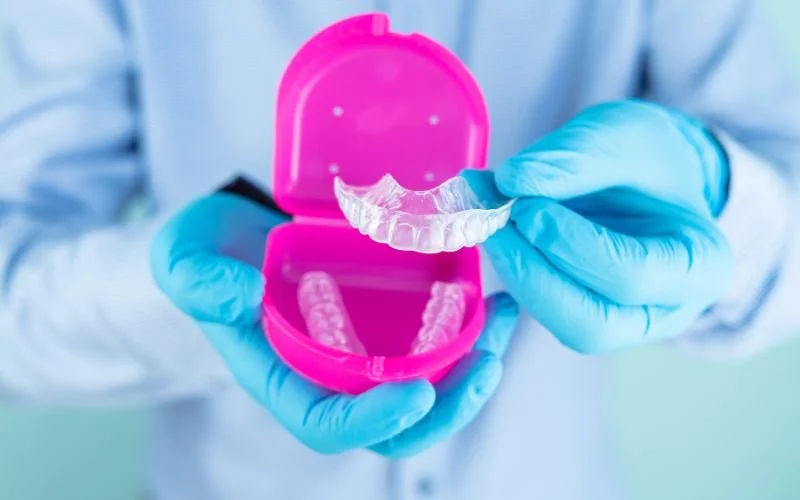What is a dental splint and what are they for? Discover its types with the help of ProDent
A dental splint is nothing more than plastic or acrylic resin elements, which cover totally or partially the surface of our dental pieces. They fulfill important functions in the treatment of some dental problems and pathologies.
In many cases the best dentists in Tijuana that you can find in ProDent, are designed exclusively for each of our patients.
For this type of cases the dentist takes an impression of our mouth and teeth, this is then sent to a dental laboratory, specifically to a prosthetic specialist.
This specialist follows the dentist's instructions to create the dental splint so that it fits perfectly to each patient's teeth.
What is a dental splint used for? Keep these points in mind
Dental splints offer our patients multiple purposes, its use is a complementary stage of some dental treatments, some of its most common uses are:
Teeth whitening: The splint is the base to place the mixture of the teeth whitening product, which should then be placed on our teeth
Bruxism or similar problems: There are types of dental splints that promote muscle relaxation, these should be used mainly at night
Avoid moving your teeth: After carrying out a periodontal or orthodontic treatment, the dental splint helps prevent the movement of our teeth and their misalignment. They are also used after a surgical intervention in our mouth
Modify the position of the jaw: There are dental splints designed to modify the occlusion of each patient. On the other hand, Invisalign orthodontics is based on these splints
There are also splints used for taking X-rays and during dental implant treatments
Types of dental splints and their use
Dental splints can be classified according to their function:
Dental splints or occlusal splints
This stands out as one of the most common types of splints, indicated for patients suffering from bruxism problems, since it avoids the friction between the upper and lower teeth, preventing dental wear, jaw pain and other discomfort caused by this disorder.
In addition to this also helps prevent dental erosion, these splints are custom made for each patient, they are made of acrylic resin, rigid and thick which makes them highly resistant to wear.
Invisible orthodontic splint
The invisible orthodontic splints or invisalign are an excellent and more aesthetic alternative to common orthodontic treatments, these splints are completely transparent and removable.
They help to move our teeth until they reach their correct position, this treatment usually includes several changes of splints that are made every 3 or 4 weeks. Each one of them treats personalized cases.
Orthodontic maintenance splint
Also known as retention splints or retainers, they should be used once the patient finishes orthodontic treatment. These splints ensure that our teeth are stabilized and the patient retains the results.
ProDent dentists recommend their constant use between 6 months and 1 year, after which time they should be used only for sleeping. These types of splints are hard, rigid and last much longer.
Periodontic splints
Periodontal splints are recommended for all those patients who suffer from periodontitis or gum infection and underwent the corresponding treatment.
They help our teeth to have no mobility, faster tissue recovery and a much more efficient healing.
The design of this type of splint depends on factors such as the type of gum lesion or severity of the infection, the relationship between the crown and root of the teeth and the movement pattern of the teeth.
Protective splints
Mouth protection splints, protective splints or sports splints are used to protect teeth from impacts and blows while practicing contact sports such as boxing, martial arts, among others...
Teeth whitening splint
This type of splint is used in the process of teeth whitening, inside the splint the whitening paste or gel must be placed and then installed on the teeth so that it can begin to act.
Although this type of splint is made of plastic, the material is a little softer than those with other functions.
How to clean a dental splint after use?
Dental splints require cleaning and maintenance to ensure that they perform their functions optimally and remain in excellent condition for a longer period of time.
To clean your splint follow the instructions of our experts at ProDent:
To clean them daily you should use a soft toothbrush, be sure to clean them both inside and outside
Do not use toothpaste, if you need to wash them in depth we recommend using a little neutral soap
If you use very aggressive products, the splint may stain or wear out quickly, so we recommend washing it with water only
Rinse the splint with plenty of water to remove all traces of dirt and products. Let it dry for at least 20 minutes before using it again.
You must remember that your mouth is full of bacteria and all of them can accumulate in the splint, if you do not apply the proper maintenance you become prone to develop oral diseases.
Also, if you give the splint the proper maintenance, care and cleaning it will last much longer.
Symptoms that indicate you need the help of a dental splint
As we have mentioned before, dental splints have multiple uses. Depending on the treatment you are undergoing or the problems your mouth presents, you may need a dental splint.
For example, dental splints are recommended for patients with the following symptoms:
Jaw pain
Clicking when opening and closing the mouth
Ear, head or neck pain that originates in the mouth
Difficulty or discomfort when biting down
If you want to know if you need a splint and what type you should use, there is no doubt that you should consult a professional dentist.
Our experts at ProDent will explain when and how you should use it if you need it, trust our personalized attention and contact us right now.





